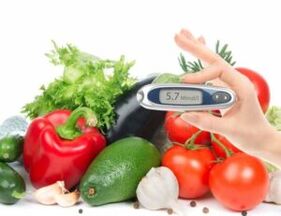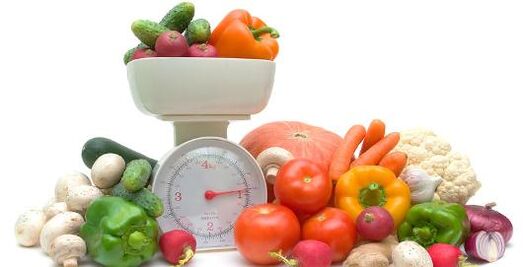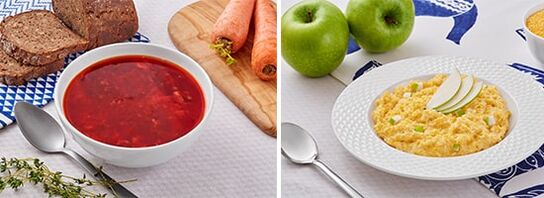
Diabetes is a chronic endocrine pathology in which the metabolism is disturbed due to the lack or improper action of the hormone insulin.
Distinguish between insulin-dependent (type 1) and non-insulin-dependent diabetes (type 2).
In the first case, patients should be injected with insulin preparations because their body's hormone production is insufficient or completely lacking.
In the second type, the interaction of insulin with cells is disrupted.
Although the mechanism of pathological development is different, the main effect of its treatment is diet and nutrition.
Diabetics' dietary characteristics
In the past, the food suppression system was the only way to suppress high blood sugar or high blood sugar levels. The patient’s diet has now expanded significantly. It is recommended that diabetics abide by several important rules for effective blood sugar control.
Patients should not starve or overeating. These conditions are dangerous to their health. You need to eat so that the amount of carbohydrates consumed is evenly distributed throughout the day.
General dietary requirements:
- Partial nutrition (at least 6 times a day);
- Calculate the carbohydrates consumed;
- Limit animal fat;
- Introduce plant foods into the diet;
- Preference to steam, put in the oven, and boil;
- Avoid foods that increase the carbohydrate load, or limit them;
- Balanced diet;
- Replace sugar with substitutes;
- Eat crude fiber food;
- Comply with the drinking system;
- Reduce salt intake;
- Eliminate alcohol.
You can diversify your diet by buying appliances that can cook food without oil.
In order to allow carbohydrates to be absorbed more slowly and not cause a jump in blood sugar, it is worth following the following suggestions:
- Eat coarse or granular foods, such as crumbly grains, rather than mashed or cooked grains.
- Meals should not be too hot, because temperature will affect the absorption of glucose.
- Fiber in food inhibits the absorption of simple carbohydrates and helps remove cholesterol.
- Simple carbohydrates are best eaten after the main meal.
The menu can include foods that contain simple carbohydrates and fiber, such as fruits and berries. If consumed with protein (protein cream) or fat, the absorption of glucose will slow down. However, don't forget that "slow" carbohydrates can also be absorbed into the blood, thereby increasing sugar.

Nutritional differences between type 1 and type 2 diabetes
Because the first and second types of diseases cause different causes of increased blood sugar, there are many ways to deal with the patient's diet. For patients who rely on insulin, nutrition is more diverse. Because they suffer from this disease more often when they are young, they include high-calorie foods in their diet. When formulating the ration, the grain units consumed are taken into consideration.
In type 2 diabetes, the main task of nutrition is to lose weight. In this case, the menu is calculated based on the calorie content of the product. The patient’s diet is stricter. They are not allowed to eat sugar, high-fat foods and foods that increase cholesterol.
Bread unit

The concept of "bread unit" (XE) is introduced to explain the quantitative composition of carbohydrates. For 1 XE, it is considered 25 grams of bread or 12 grams of sugar (carbohydrates). Diabetics need a bread unit graph to calculate the short insulin administered.
1 XE requires 2-4 units. insulin. Individuals who require additional insulin administration under XE need to use a self-control diary to determine this, which must be kept by the patient.
In one meal, the intake of diabetic patients should not exceed 7 XE. The main carbohydrate load occurs in the first half of the day.
In order to not always calculate the bread unit based on the weight of the product, we created the product table, taking into account their energy value.
What is the glycemic index of food
The glycemic index (GI) is an indicator that shows how much blood sugar increases when using a particular product compared to taking glucose.
High GI foods (70 or more):
- Honey,
- glucose;
- sugar;
- Mashed potatoes;
- Sweet soda
- Candy-corn on the cob, puffed rice.
Average GI (56-69):
- melon;
- banana;
- oatmeal;
- Black bread.
The lowest GIs are:
- Dairy products
- milk;
- fruit;
- Peas, beans, lentils and other legumes.
The absorption rate is affected by cooking, food integrity and temperature.
In diabetes, only low-to-medium GI foods are allowed.
List of allowed and prohibited products
Diabetes patients with different diseases have different dietary principles. However, some dishes are not recommended by endocrinologists.
The prohibited food list includes:
- Fried potatoes, french fries, french fries;
- Sweet fruit-grapes;
- Fat
- bacon;
- Canned oil
- Meat sauce;
- Sweet curd
- Sweet yogurt
- Margarine;
- White bread and white flour pastries;
- Juice in the store;
- soda;
- Alcohol;
- Candy, chocolate;
- jam;
- condensed milk;
- fast food.
Patients will have to fall in love with these foods and drinks:
- mineral water;
- Candied rosehip
- vegetable juice;
- Freshly squeezed juices of sweet and sour berries and fruits;
- Unsweetened citrus fruits;
- Frozen and fresh berries;
- Low-fat dairy products without sugar;
- Dietary meat-chicken, turkey, veal, rabbit;
- cabbage;
- Beans
- mushroom;
- tomato;
- eggplant;
- Green vegetables;
- asparagus;
- broccoli;
- milk;
- Whole wheat baked goods;
- seafood;
- fish.
To reduce the starch content of vegetables and grains, it is recommended to soak them before cooking.
Menu compilation rules
When compiling the menu, not only the carbohydrate content and calories of the food should be considered, but also the activity level of the diabetic. Exercise can lower blood sugar levels. In type 1 diabetes, it is recommended to take 1 XE for every hour of exercise. This will prevent you from changing the bolus insulin dose.
For obesity, a dietitian helps to formulate a diet, taking into account the energy content (calorie content) of the food and the daily energy expenditure during physical activity. This calculation takes into account the patient’s gender, age, and degree of obesity. It is allowed to arrange fasting days (with type 2 diabetes). However, fasting is contraindicated in such patients.
During the preparation of the menu, the general condition of the diabetic patient is taken into consideration. Pregnant and lactating women, adolescents, and frail patients need protein. If the patient has kidney or liver damage, ketoacidosis, the protein intake is reduced.
Don't forget other nutrients involved in metabolism: vitamins, zinc, copper, and manganese. As patients are susceptible to cardiovascular diseases, the salt content in the dishes will be reduced.
Sample menu for the week
on Monday
- Breakfast: buckwheat porridge, protein bran butter bread, tea;
- Snack: cabbage and egg salad;
- Lunch: chicken soup, herb vegetable salad, white meat steak with green beans, candied fruit, diabetic rye bread;
- Afternoon snack: bread with yogurt;
- Dinner: steamed fish, rye bread, vegetable salad;
- Snack: fermented milk beverage.
Tuesday
- Breakfast: oatmeal, butter bread, tea;
- Snack: parsley, onion and mushroom salad;
- Lunch: pea soup, vegetable grilled chicken, vegetable salad, grain bread, drinks;
- Afternoon snack: fermented baked milk with biscuits;
- Dinner: fish stew with vegetables, grain bread, fruit juice;
- Snacks: Yogurt.
Wednesday
- Breakfast: porridge "Artek", protein bran bread with butter, coffee;
- Snack: celery, apple and carrot salad;
- Lunch: borscht, buckwheat porridge with steamed ribs, sauerkraut salad, protein bran bread, preserves;
- Afternoon snack: cheese with fruit;
- Dinner: sauerkraut and meat, protein bran bread, fruit juice;
- Snack: baked apples.
Thursday
- Breakfast: eggs, buttered rye bread, tea;
- Snack: cheese with yogurt;
- Lunch: green borscht, grilled eggplant meat, tomato salad with low-fat sour cream, rye bread, candied fruit;
- Afternoon snack: pudding with tea;
- Dinner: vegetable stew, rye bread, drinks;
- Snack: kefir bread.

Friday
- Breakfast: barley porridge, butter bread, tea (chicory, coffee);
- Snack: fruit salad with yogurt;
- Lunch: fish soup, fish steak with vegetables, sweet pepper and cucumber salad, grain bread, citrus drink;
- Afternoon snack: bread and milk;
- Dinner: Steamed meatloaf with milk sauce, porridge, cereal bread, lemonade;
- Snacks: Fruits.
Saturday
- Breakfast: omelet with veal, protein bran bread with cheese, tea;
- Snack: cheese with berries;
- Lunch: mushroom soup, boiled (roasted) meat porridge, canned onions and vanilla peas, protein bran bread, preserves;
- Afternoon snack: oatmeal cookies with fermented roasted milk;
- Dinner: zucchini meat, porridge, protein bran bread, drinks;
- Snack: fermented roasted milk.
Sunday
- Breakfast: brown rice, minced meat, cabbage (cabbage roll), butter rye bread, tea;
- Snack: bread with yogurt;
- Lunch: meatball soup, chicken omelet, red cabbage salad, rye bread, drinks;
- Afternoon snack: kefir with biscuits;
- Dinner: fish cakes, baked potatoes, rye bread, drinks;
- Snack: biscuits and milk.
The trial menu is prepared by a nutritionist. In the future, people with diabetes will supplement their diet according to the doctor's recommendations.
Ready-to-eat food for diabetics
It takes a lot of time and energy for diabetics to eat well. Most diabetics simply don’t have enough time to make menus and prepare food correctly, so now I want to introduce you to Cryodieta, a company that helps diabetics make their lives easier.
Cryodieta is a delivery service that provides ready-made delicious food for diabetics and people who want to lose weight. The menu is prepared by competent experts-nutritionists and doctors.
Thanks to the special "quick freezing" technology, you only need to heat the food in a microwave oven or a multi-function pot to enjoy delicious dishes. At the same time, freezing retains all the nutrients.
The main advantages of "Cryodiet":
- Production of products in the ecologically clean zone of the Novgorod region;
- Deliver in person without delay;
- All kinds of food
- Quick freezing (keep food free of preservatives);
- Compared with competitors, the price is more affordable.
Examples of dishes

Ready-made food delivery services for diabetics operate in big cities, so if you want to eat healthy weight-loss food without spending a lot of time, please order a weekly menu on the official website.
Sugar substitute
In order to prevent patients from lacking sweets, sweeteners can be added to the dishes. They are divided into three groups:
- Carbohydrates-fructose, sorbose, xylitol, sorbitol, molasses.
- Protein sweetener-miracle, monellin.
- Synthesis-Aspartame, sodium cyclamate.
Endocrinologists recommend the use of natural sweetener stevia. Its leaves contain a glycoside complex that is 200 times sweeter than sugar. Sweeteners are beneficial for obesity, high cholesterol and high blood sugar. Due to its ability to normalize metabolism, stevia helps restore the liver's anti-toxic function.
Plant glycosides can stimulate immunity, reduce sugar levels, and have a beneficial effect on the digestive system and endocrine system. Drinks containing stevia extract can correct cravings for sugary and fatty foods and help you get rid of excess weight.
If you learn how to adjust your diet and use healthy sweets instead of sugar, high blood sugar is not a death sentence for the patient. Also, don't forget the mandatory consultation with an endocrinologist.
































































